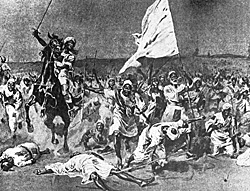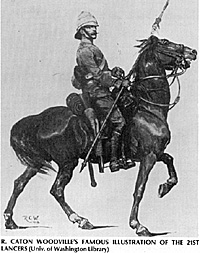THE BATTLE OF OMDURMAN
 THE MAHDIST CHARGE AT OMDURMAN (Author's Collection)
THE MAHDIST CHARGE AT OMDURMAN (Author's Collection)
The Anglo-Egyptian army was arrayed in a huge semi-circle around Egaiga. The line, only two ranks deep, extended for perhaps two miles with both flanks resting on the banks of the Nile. The southern portion of the semi-circle was held by the two British brigades behind a thorn-bush zeriba. The central and northern portions were held by three Egyptian brigades in shallow trenches behind low parapets made from the sand removed from the trenches. The fourth Egyptian brigade was held in reserve within the perimeter. From the river, the gunboats offered additional support.
The Sirdar's army spent an uneasy night on 1-2 September, fearful of a night attack by the Mahdists. A night assault would virtually rob the Anglo-Egyptian troops of their huge firepower superiority. Though his advisors pressed hard for an assault under the cover of darkness, the Khalifa ruled out such an attack under the pretense that he would be unable to control his troops or visually communicate with his generals in the darkness.
The strength of the Mahdist army at Omdurman has been variously given as anywhere between 30,000 and 52,000 men. The lower figure is probably closer to correct than the high estimate, given by the British in their "official" accounts. The best reason for the abnormally high figure given by the British was to lessen the impact of the Mahdist casualty figures when the reports of the battle hit the newspapers back home. An estimate of 35-40,000 effectives seems to be the most historically accurate figure. The Khalifa's army was divided into three major and two minor commands for the attack.
Four of these commands were identified by the flags which the men rallied around:
- the Dark Green Flag of the Mulazimiyya (the Khalifa's bodyguard) numbering 10-15,000 men under the command of Abdallahi's son, Uthman Shaikh al-Din
- the Black Flag commanded by Yaqub, about 12-15,000 men; the Green Flag of Ali wad Hilu containing some 4,000 men
- the Red Flag of al-Sharif, numbering only a few hundred men;
- and Uthman Diqna's followers (who had no flag because it had been captured at Tamai in 1884) numbering between 1,000 and 4,000 men.
As Kitchener had nearly 26,000 men supported by artillery and gunboats, the task of the Mahdists, with less than a 2:1 advantage in manpower, was monumental at least. Though the Khalifa possessed over 60 pieces of artillery, most of these were mounted in forts along the Nile. Only 10 mountain guns were used in the battle, and none to any effect. The locally manufactured shells used by the Khalifa's gunners were inferior to the guns' original ammunition, most exploding prematurely or falling harmlessly shortof the Anglo-Egyptian lines.
The opening attack was made a little before 7:00 AM by the Green Flag and the Mulazimiyya with the Red Flag and Uthman Diqna's troops attached. Better than half of this force was drawn north, away from the zeriba, into the Kerari Hills in pursuit of the Egyptian Cavalry and Camel Corps. Shrapnel, maxim and rifle fire from the Anglo-Egyptian army checked the ansar charge about 300 yards out from the zeriba.
For a while the Mahdist riflemen found some cover in a slight depression and exchanged shots with Kitchener's men. By 8:00 AM, though, they couldn't withstand the concentrated maxim and rifle fire any longer and the survivors withdrew. Meanwhile the Egyptian Camel Corps found themselves cut-off from the main force by the Green Flag troops who were pursuing them. The timely arrival of two gunboats with their supporting fire pushed the Mahdists back from the banks of the Nile, allowing the Camel Corps to slip into the zeriba and avoid a major catastrophe.
 R. CATON WOODVILLES FAMOUS ILLUSTRATION OF THE 21ST LANCERS (Univ. of Washington Library)
R. CATON WOODVILLES FAMOUS ILLUSTRATION OF THE 21ST LANCERS (Univ. of Washington Library)
At about 8:30, Kitchener sent the 21st Lancers south to scout the approaches to Omdurman. As the Lancers advanced, scouts reported a group of hostiles to the front. Despite orders to only reconnoiter and harass the enemy, the Colonel of the Lancers ordered a charge to clear out the Mahdists. Galloping full-tilt over unknown ground and against an enemy of unknown strength and disposition, the cavalry quickly approached the khor (dry watercourse) in which the Mahdists were hiding.
Suddenly, hundreds of ansar sprang up to meet the charge. Surprised, but too far committed to abort the charge, the cavalry struck the Mahdists and hacked their way through the khor. The Lancers continued well past the Mahdists before rallying. They then dismounted and scattered the ansar with sustained carbine volleys. The charge, even though it had succeeded, had been costly. The 21st Lancers lost 21 killed and 50 wounded.
Even worse was the loss of 119 horses. In one mis-directed charge, the Lancers removed themselves from Kitchener's list of effective units. The press coverage which the charge received in Britain helped hide the fact that the Colonel made a mistake in ordering the maneuver in the first place.
While the Lancers were mixing it up with the Mahdists in the south, Kitchener ordered his troops out of the zeriba and to form up for the triumphal march into Omdurman. It is not clear whether the Sirdar forgot about Yaqub's yet uncommitted Black Flag troops or that he honestly felt that all of the Mahdists had been defeated in the first charge. Most of the troops were ordered to march south or south west, over the Jebel Surgham (a ridge between Egaiga and Omdurman). MacDonald's Egyptian brigade soon found itself separated from the other brigades as they headed for the Khalifa's capital. At about 9:30, Yaqub and his Black Flag troops came pouring around the western slopes of the Jebel Surgham and headed straight for MacDonald's men.
Kitchener, realizing his mistake, ordered the other brigades to make a quick turn to the right and march at full speed to support the isolated Egyptian brigade. MacDonald's men held the charge at bay until help arrived to send Yaqub's men retreating. Once again, steady volleys from well-disciplined men prevented the ansar from ever approaching close than 300 yards. Before the Anglo-Egyptian tropps could reform and continue their march to Omdurman, Uthman Shaikh al-Din's Mulazimiyya (returning from their pursuit of the Egyptian cavalry) appeared in the Kerari hills and briefly threatened the flank of MacDonald's brigade. They arrived too late to coordinate their efforts with Yaqub's attack, however, and the fire of the Egyptian troops soon had the mulazimiyya joining the rest of the Mahdists in flight.
For all intents and purposes the battle of Omdurman was now over. Kitchener's army had survived the crisis of Yaqub's attack, but the margin of victory was closer than the Sirdar thought. A check of ammunition in MacDonald's brigade found that the men averaged only two rounds. remaining for their Martini-Henrys! At 11:30 AM, all firing had ended and the army once again began marching towards Omdurman. The Mahdist casualties were appalling- 10,800 dead and an estimated 16,000 wounded-quite a testimony to the effect of late- Victorian weapons against spears and swords. The Sirclar's army suffered 48 dead and 382 wounded, 16% of these were suffered by the 21st Lancers, so the casualties to the main force were even less.
AFTER OMDURMAN
The army entered Omdurman in triumph. They then crossed the Nile where a memorial service to General Gordon was held at the ruins of the Governor's Palace. The Mahdi's Tomb in Omdurman already damaged by shelf fire from the gunboats, was blown up anj Muhammad Ahmad's bones were thrown into the Nile. Worried about the French, the Sirdar steamed south with five gunboats loaded with troops on the 10th of September. On the 19th, the flotilla arrived at Fashoda and was greeted by a fort flying the tricolor and garrisoned by 120 French askaris, commanded by Major Marchand. After cautious negotiations, including some which narrowly avoided an armed conflict between the two major powers, Kitchener and Marchand agreed to a "joint" occupation of Fashoda until their respective governments could decide the issue.
The French were firm in their claims and the British realized that they held the weaker hand, but they pressed hard for a withdrawal of Marchand and his men. Public uproar in both countries soon had the Fashoda question escalating to the brink of war. The French Mediterranean fleet sailed to Cherbourg. Supplies were gathered up by both countries and war in Europe seemed only weeks away. Suddenly, without explanation, the French backed down and ordered Marchand and his men out on November 2, 1898.
Mopping-up operations continued against the Mahdists, even while the Fashoda incident was in the forefront. Ahmad Fadil, with an army of about 6,000 men, was still at large in the territory to the southeast of Omdurman. Ahmad, cut-off from the Khalifa and the remnants of the Mahdist army by the Egyptian-controlled Nile, tried to cross anyway and rejoin his leader. A two-pronged advance was made against his forces by the Egyptians from Khartoum and Kassala. On the 26th of December, his army was met and defeated at Roseires. About 2,000 ansar were killed or captured and the remainder scattered. Only Ahmad and a handful of his men were finally able to cross the Nile and rejoin the Khalifa.
Throughout 1899, the Khalifa and his remaining troops were systematically hunted down by the Egyptians. Finally cornered at the wells of Gedid, Abdallahi and about 5,000 men turned to meet Colonel Wingate's Egyptian flying column on the 24th of November, 1899. The battle didn't last long, the only change from previous actions was that the Khalifa and his men did not flee. Abdallahi, his generals and his relatives calmly unrolled their prayer blankets in the midst of the battle and sat, awaiting their fate. They were all killed. The Sudan campaigns and the Mahdist state in the Sudan had come to an end.
More Sudan Part II
- The Khalifa Takes Control, 1885
The Invasion of Egypt, 1889
The Dongala Expedition, 1896
Advance to Omdurman, 1897
Battle of Omdurman, 1898
More Sudan
-
The Sudan Part I: Introduction: The Mahdi
The Sudan: First British Involvement 1884-85
The Sudan: Anglo-Egyptian Sudan Map
The Sudan: Illustration: Troop Types of Hicks' Expedition (slow: 139K)
Sudan War Bibliography
Lynn Bodin: Bio of Theme Editor for Sudan
Whalers on the Nile: Sudan Transport Boats
Wargame Figures for the Sudan
Colonial Era Wargame Rules Overview
Back to Table of Contents -- Courier Vol. V #4
To Courier List of Issues
To MagWeb Master Magazine List
© Copyright 1984 by The Courier Publishing Company.
This article appears in MagWeb (Magazine Web) on the Internet World Wide Web.
Other military history articles and gaming articles are available at http://www.magweb.com